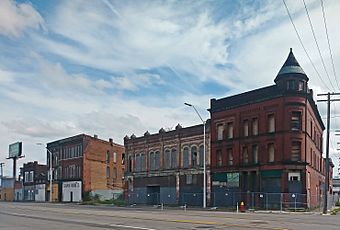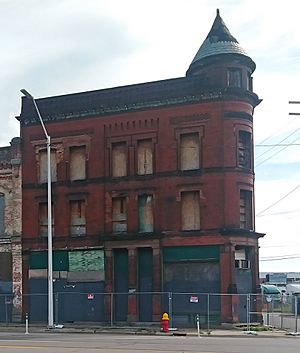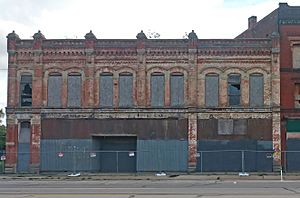Michigan Avenue Historic Commercial District facts for kids
Quick facts for kids |
|
|
Michigan Avenue Historic Commercial District
|
|

3300 block of Michigan
|
|
| Location | South side of 3301-3461 Michigan Ave. Detroit, Michigan |
|---|---|
| Built | 1884 |
| Architect | Peter Dederichs Jr., Joseph E. Mills |
| Architectural style | Italianate, Commercial Style |
| NRHP reference No. | 100005169 |
| Added to NRHP | April 8, 2020 |
The Michigan Avenue Historic Commercial District is a special collection of old shops and buildings in Detroit, Michigan. These buildings are found along a part of Michigan Avenue. This area is important because it has the best-preserved group of buildings from a long time ago on this street. The district was added to the National Register of Historic Places in 2020. This means it's a place worth saving and remembering for its history.
Contents
A Look Back in Time
German Settlers and Early Shops
In the mid-1800s, many German immigrants came to Detroit. They first settled on the east side of the city. As Detroit grew, the German community moved west. They built a new neighborhood beyond Corktown. The main shopping area for this community was along Michigan Avenue. This was between 22nd and 24th Street.
By 1887, this part of Michigan Avenue was full of brick buildings. These buildings housed many different businesses. There was a wood and coal shop, a carriage repair shop, and a shoe store. You could also find a saloon, a butcher, and a grocery store. New buildings like the Reeber Building (1887) and the Schulte and Kaiser Building (1889) were built then. By 1897, shops filled both sides of Michigan Avenue. However, most buildings on the north side are now gone. Only the south side remains today.
Growth and Change
Around 1900, Detroit became a big manufacturing city. Many factories were built near the district. This made the nearby neighborhoods popular for factory workers. The shops along Michigan Avenue did very well. All sorts of businesses opened there.
As cars became more common, factories grew even bigger. By 1929, the district was still a busy shopping area. It had a grocer, a jeweler, a movie theater, and a candy store. There was also a bank, an interior decorator, and a furniture store.
Hard Times and Decline
By 1940, the Great Depression had caused problems. Many shops became empty. In the mid-1930s, Michigan Avenue was made wider. This project also caused some buildings to be torn down. Many of these were on the north side of the street.
By 1950, many car factories had moved away. They went to bigger, newer locations. The neighborhood around the district started to decline. The style of the buildings in the district also seemed old-fashioned. Newer, more modern buildings were being built elsewhere. A city plan removed many houses south of Michigan Avenue. This made room for more industry. The area became less desirable for people to live in. Businesses along Michigan Avenue slowly disappeared. By the late 1960s, many buildings were empty.
What the District Looks Like
This historic district covers two blocks of Michigan Avenue. It has 18 buildings in total. Thirteen of these buildings are very important historically. They are all commercial buildings. They range from one to three stories tall. Most were built between 1884 and 1925.
These buildings show typical styles from the late 1800s and early 1900s. You can see Italianate and Commercial Style designs. Some buildings have been updated over the years. Their fronts might look a bit different now.
The important buildings in the district include:
- Wolverine Theater (3301 Michigan Avenue): Built around 1918. This is a one-story brick building. It has a tall wall at the top, originally for signs. Its front is covered with vertical wood siding.
- 3311 Michigan Avenue: Built around 1922. A one-story brick building with a flat roof. The front has brick columns and a stone top.
- 3315-3317 Michigan Avenue: Built around 1898. This is a two-story brick building with a flat roof. It has two entrances. One is in the middle, and a smaller one leads to apartments upstairs. A stone ledge connects the second-story windows. The roofline has decorative brickwork.
- 3321 Michigan Avenue: Built around 1910. A one-story yellow brick building with a flat roof. The shop front is framed by brick pillars. Metal brackets support a metal ledge above.
- 3325 Michigan Avenue: Built around 1896. A three-story yellow brick building with a flat roof. The second and third floors have a large, round arch in the middle. This arch is set back a bit. Inside the arch is a bay window on the second floor and a door on the third. Windows are on either side of the arch. The third-floor windows are arched.
- 3333 Michigan Avenue: Built around 1900. A three-story red brick building with a flat roof. It has two main parts. One is narrow with a door and single windows above. The other is wider with a shop front and three sets of double windows above.
- Reeber Furniture Company Building (3363 Michigan Avenue): Built in 1887. Peter Dederichs, Jr. and Joseph E. Mills designed it. This is a two-story brick building, about seventy feet long. Its front has three parts, separated by brick pillars. These pillars have stone tops and decorations. The second-floor windows have arched stone frames. A decorative brick ledge runs along the roof.
- Grosfield Building (3365 Michigan Avenue): Built in 1893. Joseph E. Mills designed it. This is a three-story brick building with a flat roof. It's the most unique building in the district. It has Queen Anne style details. These include textured stone, patterned brick, and terra cotta decorations. It also has semi-circular arched openings and a round tower with a cone-shaped roof. Stone bands run between the floors.
- People's State Bank (3401 Michigan Avenue): Built in 1925. A one-story building with a flat roof. It is covered in limestone. The building has three sections facing Michigan Avenue. It has eight sections along the side street. The main entrance is set back. It has Ionic columns on either side. The front door has a triangular frame above it.
- 3415 Michigan Avenue: Built around 1884. A two-story brick building with a flat roof. This building was built as part of a group of three. The others are 3419 and 3423 Michigan. It is divided into four sections.
- 3419 Michigan Avenue: Built around 1884. A two-story brick building with a flat roof. This building was also built as part of the group of three. The ground floor shows signs of arched windows. These are not on the other two buildings. It is divided into four sections.
- 3423 Michigan Avenue: Built around 1884. A two-story brick building with a flat roof. This building was the third in the group built together.
- Schulte and Kaiser Grocery Building (3461 Michigan Avenue): Built around 1889. Peter Dederichs, Jr. designed it. A two-story brick building with a flat roof and a projecting wall at the top. It has eight sections and two shop fronts. The shop fronts are currently filled in. There is a corner entrance at one end. The shop fronts and corner entrance have decorative brick pillars with stone details.
See also
 In Spanish: Distrito Comercial Histórico de la Avenida Míchigan para niños
In Spanish: Distrito Comercial Histórico de la Avenida Míchigan para niños



